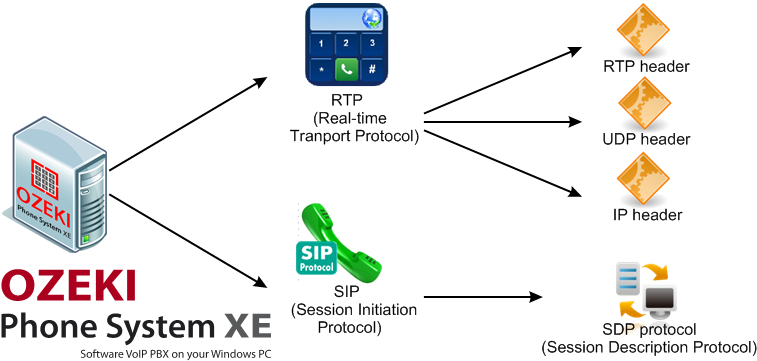RTP vs. SIP
The article discusses the RTP and SIP protocol that are both important elements in the communication process via the Internet. RTP is used for data transfer and SIP protocol uses RTP when establishing channels for communication. If you are interested in this topic, read through the article and also watch our video.
RTP (Real-time Tranport Protocol) is a peer-to-peer protocol that describes how video and audio data is transmitted through the Internet.
SIP (Session Initiation Protocol) is an IP telephony signaling protocol. It establishes, modifies and also ends VoIP calls. Ozeki Phone System has a great support for VoIP technology that applies RTP and SIP for the communication (Figure 1)

How Do RTP and SIP Work
Real-time Transport Protocol is very much like the Internet Protocol or TCP (Transmission Control Protocol). The protocol delivers multimedia data to endpoints of communication. There are different networks through that the interactive multimedia data can be transmitted. The RTP protocol transmits RTP packets that has 3 headers: an RTP header because it is transmitted via RTP, a UDP header because an RTP packet is also called an UDP packet and furthermore it consists of an IP header.
The Session Initiation Protocol describes the communication between endpoints of the communication. The protocol is responsible for only building up the connection and it also ends/terminates the communication channel. Several other protocols are used by the SIP protocol such as XML, SMTP, HTTPS, POP, etc. SIP reuses them in its work process. SIP also uses SDP protocol (Session Description Protocol) for signaling and uses RTP for transporting data.
Usage of the Protocols
The RTP protocol is primarily used by communication and entertainment systems for media data streaming and push to talk features. RTP protocol is also used by transfer and network protocols.
The SIP protocol is simply responsible for creating a communication channel between VoIP phones or computers. In order to receive and make VoIP phone calls, the following devices are needed: microphone and a speaker. SIP is used in IP telephony services. Especially, businesses apply the Session Initiation Protocol for creating a communication system that works through the Internet.
Features
RTP protocol has several components: RTP that is responsible for transferring data, RTCP that is responsible for controlling the data and it can also use signaling protocols such as H.323 or SIP protocols. RTP supports several file formats like MPEG and MJPEG but you can add extra formats. RTP also has jitter compensation, multimedia streaming (tolerates packet loss) and detection of out of sequence arrical in data attributes.
SIP protocol has basic support for SDP (Session Description Protocol) and TCP, call hold, SIP profiles, transcoding, session timer, can interwork with other protocols, etc. Furthermore, SIP has the following features: routing, it can handle calls, SIP extensions. The Session Initiation Protocol can also support many functionalities of a PBX, unified messaging (voice, fax, text, e-mail messages, media), video conferencing and voice mail to e-mail.
Ozeki Phone System provides a great support for both RTP and SIP protocol. Ozeki Phone System can establish communication channels between endpoints with the help of the SIP protocol and transport data from one point to another with RTP protocol.
Read through the following articles in relation with RTP and SIP:
- H.323 Protocol explained
- SIP Protocol explained
- VoIP Calling explained
- What is VoIP Phone?
- What is RTCP?
- What is SRTP?
If you became interested in this topic, please watch our video:
RTP vs. SIP (Video tutorial)
